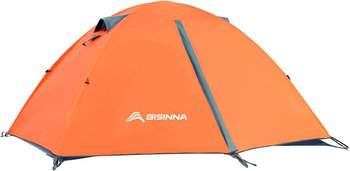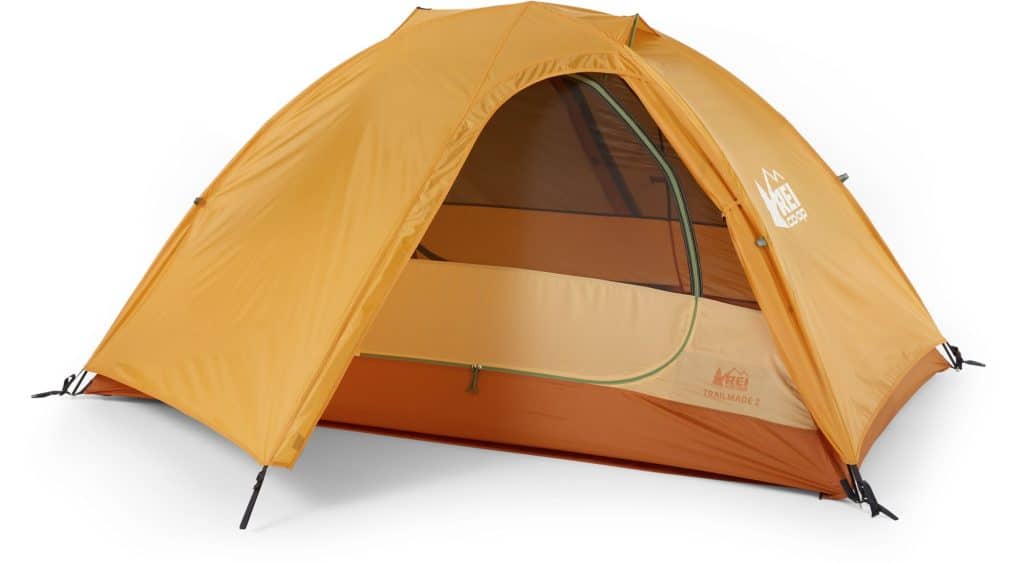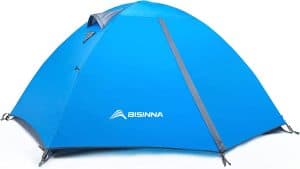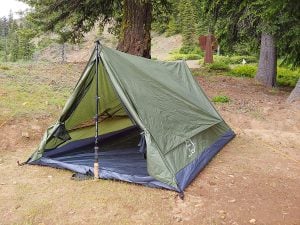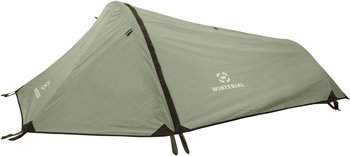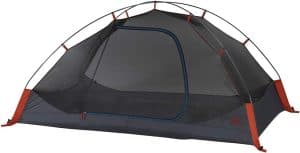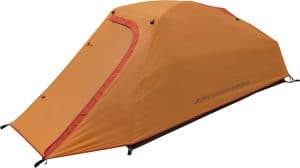In a rush and looking for the best budget backpacking tent on the market, look no further than the REI Co-op Trailmade 2 w/ Footprint
Backpacking for the first time? Your 4-person tent won’t cut it – you need something way lighter for this adventure.
But you also don’t have to break the bank by buying an expensive backpacking ten, when there are amazing budget models out there.
Here are the best budget backpacking tents on the market today:
Best Budget Backpacking Tents Under $100:
- Best Low Budget Backpacking Tent: BISINNA 2 Person Camping Tent
- Best Low Budget A-Frame Backpacking Tent: River Country Products Trekker Tent
- Best Low Budget Ultralight Hot Tent: OneTigris Smokey Hut Ultralight Hot Tent with Stove Jack
- Best Low Budget 1-Person Backpacking Tent: Clostnature One-Person Tent
- Best Low Budget Bivy Tent: Winterial Single Person Personal Bivy Tent
Best Budget Backpacking Tents Under $200:
- Best Overall Budget Backpacking Tent: REI Co-op Trailmade 2 w/ Footprint
- Best Budget Backpacking Tent for Bad Weather: The North Face Stormbreak 2
- Best Budget Backpacking Tent with a Vestibule: Kelty Late Start 2
- Best 1 Person Backpacking Tent: ALPS Mountaineering Zephyr 1-Person Tent
More on how we test and review tents here.
Best Budget Backpacking Tents Under $100
BISINNA 2 Person Camping Tent
Size: 2 person | Season: 3 | Weight: 4 lbs 12 oz | Min Trail Weight: 4 lbs 12 oz | Max Inside Height (in): 47.2 | Floor: 82.7 x 44 in (31.6 sq ft) | Vestibule(s): 2 (6.7 + 6.7 sq ft) | Setup Time: 10 mins
OVERALL SCORE | 7.8 |
Space & Comfort | 8 |
Quality & Durability | 6 |
Value | 9 |
Weather Resistance | 7.5 |
Ease of Use | 8 |
Intangibles | 6 |
User Reviews | 9.4 |
Even though this tent is the most affordable among budget tents on this list, it definitely stands out with its features.
First, it has two large D-shaped doors with dual zippers, which provide excellent ventilation and make getting in and out of the tent so much easier.
This is not that common for backpacking tents, especially at this price range.
The tent itself is also really well-made, featuring a 190T polyester taffeta rainfly and no-see-um mesh inner walls. Together, they make the tent both water-resistant and breathable.
One thing I’m amazed by is the fact that the brand offers a lifetime warranty on their products, including this tent.
You can rest assured that you’ll get your money’s worth, or your money back.
Pros:
- With a PU rating of 2000mm, this tent can withstand heavy rain
- Adjustable high-level vents help you reduce condensation in rainy weather
- The inner tent and rainfly can be connected with buckles for additional stability and tautness
- Comes with a 30-day money-back guarantee and a limited lifetime warranty, making it a risk-free purchase
Cons:
- Vestibules are rather small
Best for: backpackers on a budget.
River Country Products Trekker Tent
Size: 2 person | Seasons: 3 | Weight (lbs): 3 lb 5 oz | Floor: 84 x 60 x 42 inches (35 sq ft) | Max Inside Height (in): 42 in | Setup Time: 5 mins
OVERALL SCORE | 8.3 |
Space & Comfort | 8 |
Quality & Durability | 7 |
Value | 8 |
Weather Resistance | 8 |
Ease of Use | 9 |
Intangibles | 9 |
User Reviews | 9.2 |
Looking for a lightweight backpacking tent that won’t break the bank?
This affordable A-frame tent is made of durable, lightweight materials like puncture-resistant polyester and Oxford taffeta, making it perfect for long-distance hikes.
While intended for use with trekking poles, it can also be set up with tall sticks or between trees for added versatility.
Although the back side is single-walled to reduce costs, the other three sides are double-walled to prevent condensation.
With larger dimensions than most two-person tents, this model offers plenty of space for a solo camper and comfortable accommodation for two.
Pros:
- You can erect the tent by suspending it between two trekking poles, long sticks or trees
- With the price it sells at, this is one of the most affordable A-frame tents on the market
- Weighs just over 3 pounds, which makes it suitable for backpacking and trekking
- Offers a bit more room compared to standard two-person tents
Cons:
- Can be difficult to pitch in tough terrains, such as gravel and sand
Best for: campers on a budget.
OneTigris Smokey Hut Ultralight Hot Tent with Stove Jack
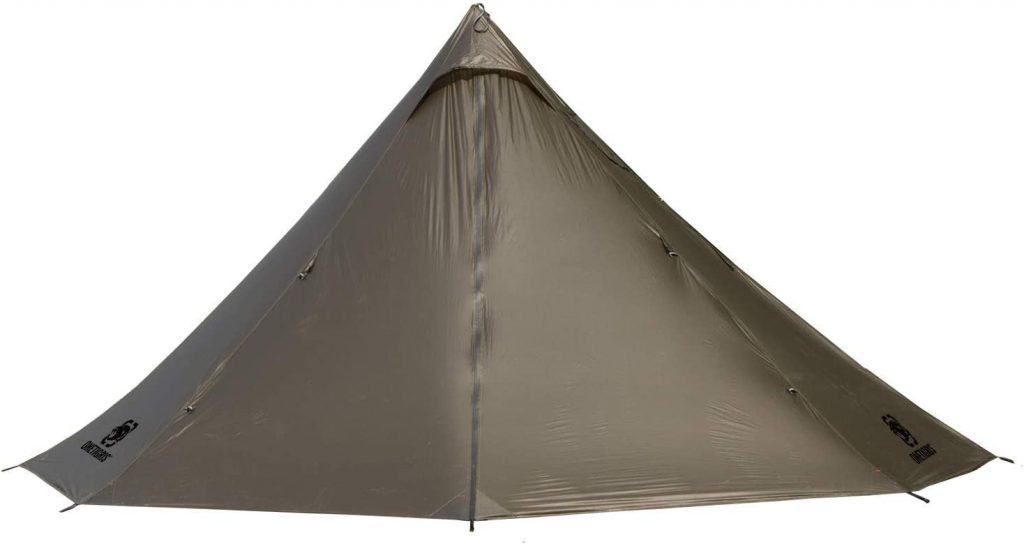
Size: 2 person | Seasons: 4 | Weight (lbs): 2.6 lbs | Max Inside Height (in): 62.9 in | Floor: 10.5 ft x 5.2 ft (86.59 sq ft) | Stove Jack Cutout: 3.3 in
OVERALL SCORE | 7.8 |
Space & Comfort | 9 |
Quality & Durability | 7 |
Value | 8 |
Weather Resistance | 7 |
Ease of Use | 7 |
Intangibles | 8 |
User Reviews | 8.8 |
This tent that features a stove jack by OneTigris is a lightweight tent at just 2.6 pounds.
It’s made with 20D nylon fabric coated with silicone, making it waterproof and resistant to abrasion. The teepee shape makes it suitable for use in three seasons, and it’s resistant to wind and rain.
This tent doesn’t come with a floor to save weight, so it may not be suitable for wet or cold weather without the addition of a tarp. With room for two people and a tent stove, it’s perfect for bushcraft and hunting.
The small size of this tent makes it fast and easy to set up, and it can be pitched alone in less than 10 minutes.
Pros:
- With just 2.6 pounds, you can hardly find a lighter tent with a stove jack
- Silicone coated, so it’s completely waterproof
- Quick and easy to set up by yourself
- Reinforced guyline tie-out points keep the tent sturdy even during wind
Cons:
- Doesn’t come with a floor
Best for: backpacking and hiking.
Clostnature One-Person Tent
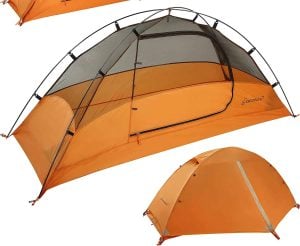
Size: 1 person | Season: 3| Weight: 4.2 lbs | Min Trail Weight: 3.7 lbs | Max Inside Height (in): 36 | Floor: 87 x 32 in (19.3 sq ft) | Vestibule(s): 2 (5.5 + 5.5 sq ft) | Setup Time: 5 mins
OVERALL SCORE 8.3 Space & Comfort 8 Quality & Durability 9 Value 8 Weather Resistance 9 Ease of Use 9 Intangibles 5 User Reviews 9
Even though it’s extremely affordable, this tent is also high-quality. When it comes to weather elements, they have nothing on this model.
With a rainfly PU rating of 5000mm, this tent will keep you dry even when it’s raining cats and dogs outside.
Plus, its dome shape and sturdy construction also stand well against the wind.
During warmer months, you can remove the fly and enjoy the night sky through the tent’s mesh body.
Only the top part of the tent walls are covered in mesh, so you can still have privacy inside the tent even when the fly isn’t on.
Impressively, this tent is one of the lightest on the list, regardless of its sturdy materials. That’s why it’s a great option when you’re backpacking long distances.
Pros:
- A PU rating of 5000mm ensures the inside always remains dry, regardless of how heavy it pours
- The large side vestibule provides decent storage space
- Reflective ropes make it easier to locate the tent in the dark
- The tent comes with a 100% risk-free satisfaction guarantee and a one-year warranty on manufacturing defects
Cons:
- Slightly lower headspace than most tents of this size
Best for: year-round solo backpacking.
Winterial Single Person Personal Bivy Tent
Size: 1 person | Seasons: 3 | Weight: 2 lbs 9 oz | Min Trail Weight: 2 lbs 9 oz | Max Inside Height: 38 | Floor: 90 x 28 in (17.5 sq ft) | Packed Size: 4.5 x 18 in
OVERALL SCORE | 7.8 |
Space & Comfort | 9 |
Quality & Durability | 8 |
Value | 8 |
Weather Resistance | 6 |
Ease of Use | 9 |
Intangibles | 5 |
User Reviews | 8.8 |
This tent is a great option for those on a budget who love bivy sacks.
Although slightly heavier than a classic bivy, it offers more space and is still a lightweight option at just under 3 pounds. It’s easy to pack and won’t take up too much space in your backpack.
The tent is double-walled, making it suitable for use from spring to fall. It comes with a waterproof rainfly made of 190T polyester, which is also windproof and has good thermal insulation properties. Additionally, the rainfly is breathable, so you don’t have to worry about condensation.
One of the best things about this tent is how easy it is to pitch. Simply stake the corners and install the poles, which shouldn’t take more than 3 minutes. The tent also comes with 14 stakes, which is more than enough to keep it in place.
While there may be lighter options available, this tent’s combination of price and features make it an excellent choice for budget-conscious backpackers.
Pros:
- The rainfly is sturdy and keeps you safe in rainy weather conditions
- This is one of the most affordable 1-person tents on this list
- Low profile keeps the tent in place even during high winds
- Large doors allow you to easily get in and out
Cons:
- A bit heavy for a bivy
Best for: camping in bad weather.
Best Budget Backpacking Tents Under $200
REI Co-op Trailmade 2 w/ Footprint (formerly Passage 2)
Size: 2 person | Season: 3 | Weight: 5 lbs 7 oz | Min Trail Weight: 4 lbs 4 oz | Max Inside Height (in): 39.9 | Floor: 88 x 51 in (31 sq ft) | Vestibule(s): 2 (9.5+ 9.5 sq ft) | Setup Time: 5 mins
OVERALL SCORE | 8.0 |
Space & Comfort | 7.5 |
Quality & Durability | 8 |
Value | 8 |
Weather Resistance | 7 |
Ease of Use | 8 |
Intangibles | 9 |
User Reviews | 8.6 |
This particular model by REI Co-op hits the top of the under $200 list for numerous reasons.
But above all, it has everything you expect from a budget backpacking tent and more.
And for a 2-person backpacking tent, there’s a decent amount of space inside.
The X-pole configuration gives more vertical space at the tent ends, so there’s more room for moving your feet at night.
For storage, the tent has interior pockets and gear loops. But the vestibules covering each tent door provide additional storage space for gear and dirty boots.
Finally, this tent comes with a footprint, which is something you don’t see very often, especially with budget picks.
The footprint ensures your tent doesn’t get damaged when used on harsh terrain.
Pros:
- Two twin stake-out vestibules provide large covered areas for storing gear
- Decent vertical interior space, so there’s more room for restless sleepers to move around
- Comes with a footprint, which keeps the tent floor protected from damage
- When not in use, fly doors can be rolled up for a clear view of the sky and improved ventilation
Cons:
- Storage pockets are somewhat small
Best for: camping on rough, rocky terrain.
The North Face Stormbreak 2
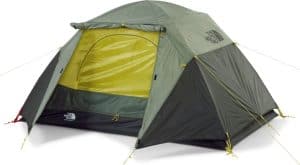
Size: 2 person | Season: 3 | Weight: 5 lbs 14 oz | Min Trail Weight: 5 lbs 5 oz | Max Inside Height (in): 43 | Floor: 87 x 50 in (30.6 sq ft) | Vestibule(s): 2 (9.78 + 9.78 sq ft) | Setup Time: 5 mins
OVERALL SCORE | 7.9 |
Space & Comfort | 7.5 |
Quality & Durability | 7 |
Value | 8 |
Weather Resistance | 8 |
Ease of Use | 8 |
Intangibles | 7 |
User Reviews | 9.4 |
When you’re backpacking, there’s a pretty good chance you’ll experience bad weather at some point.
But this tent by The North Face will keep you safe from the elements.
The fly is made of 75D polyester and coated with polyurethane to prevent water from seeping through.
During rain, both doors can be closed completely, while high-low ventilation ensures there’s optimal airflow inside.
This particular model has a pretty good headspace for a 2-person tent.
The peak height is 42 inches, while the walls meet the floor at around a 60-degree angle.
That way, there’s more room for your feet when you’re sleeping.
Pros:
- The rainfly covers the entire tent, ensuring no rain can get inside
- Tall ceiling and almost vertical walls provide decent interior space for a 2-person tent
- Features two vestibules which offer a decent area for storing gear outside
- Interior mesh pockets are rather wide, so there’s more room for storing your necessities
Cons:
- Not as light as most other models on the list
Best for: camping in rainy weather.
Check Price at Dick's Sporting Goods
Kelty Late Start 2
Size: 2 person | Season: 3 | Weight: 4 lbs 8oz | Min Trail Weight: 4 lbs| Max Inside Height (in): 40 | Floor: 85 x 54 in (29.5 sq ft) | Vestibule(s): 1 (7.85 sq ft) | Setup Time: 5 mins
OVERALL SCORE | 7.8 |
Space & Comfort | 7 |
Quality & Durability | 7 |
Value | 8 |
Weather Resistance | 7 |
Ease of Use | 9 |
Intangibles | 7 |
User Reviews | 9.4 |
With backpacking tents, you don’t expect a lot of room for storing gear inside.
But an ample vestibule would with the necessary storage space without adding weight, which is the case with this model.
This is one of the lightest models on the list, so it’s great for long-distance trips. To save up on weight, it only features one door.
But there’s a decent-sized vestibule covering the door that reaches all the way to the ground. So not only it keeps your tent safe from rain and wind,
It also does the same for your gear stored outside.
It’s also worth noting that this tent is very quick and easy to pitch.
Kelty’s Quick-Corner Technology holds the pole ends securely in place during pitching, while a pre-bent pole system ensures the construction remains stable.
Pros:
- A large vestibule offers ample storage space and prevents rain from getting through the door
- Quick-Corner Technology helps you pitch the tent without the help of anyone
- Very lightweight, so it’s ideal for long-distance trips
- Large mesh tent body allows stargazing during warm, dry summer nights
Cons:
- Only has one door, making it harder for two campers to get in and out
Best for: ease of pitching.
ALPS Mountaineering Zephyr 1-Person Tent
Size: 1 person | Season: 3 | Weight: 4 lbs 12 oz | Min Trail Weight: 3 lbs 15 oz | Max Inside Height (in): 36 | Floor: 86 x 44 in (23 sq ft) | Vestibule(s): 2 (5.5 + 5.5 sq ft) | Setup Time: 5 mins
OVERALL SCORE | 8.8 |
Space & Comfort | 9 |
Quality & Durability | 8 |
Value | 9 |
Weather Resistance | 9 |
Ease of Use | 9 |
Intangibles | 8 |
User Reviews | 9.2 |
If you’re camping solo and with minimum gear, then you can save up on weight by choosing a 1-person model, like this one by ALPS Mountaineering.
For a 1-person tent, the inner space isn’t too bad. The side walls are vertical, ensuring more headspace while keeping the same floor dimensions.
A 36-inch center height allows you to sit upright inside the tent when needed.
While there’s not much room inside for anything else but your sleeping pad and bag, there’s space outside for storing your gear.
The vestibule at the entrance is pretty ample, so there’s room for your backpack as well as your dirty boots.
Pros:
- A center height of 36 inches gives you enough room to sit up and move around
- Redesigned frame shape increases interior space while not keeping the same floor dimensions
- The tent uses 7000 aluminum poles, which are very sturdy and weatherproof.
- With a 3000mm PU rating, this tent can withstand heavy rain pour
Cons:
- Aside from the door, there’s no additional opening for ventilation
Best for: solo backpackers.
Buying Advice For Budget Backpacking Tents
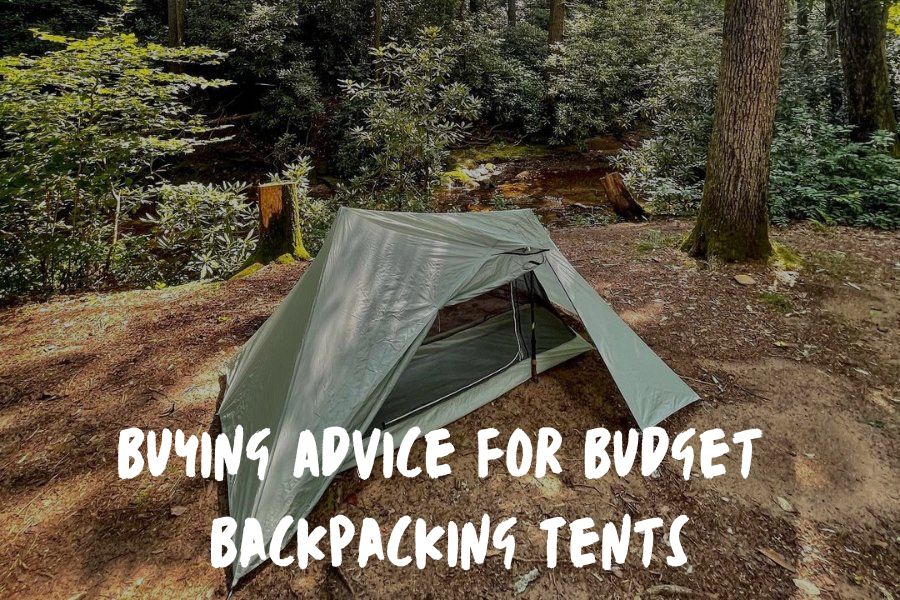
When you’re buying a tent, there are always some things to keep an eye on. In the case of budget models, you might not get a lot of bells and whistles, but there are still some important features to look for.
How We Define a “Budget” Backpacking Tent
As you know, tents aren’t exactly the most affordable piece of camping gear. Still, they do come with different price tags.
When we’re talking about budget tents, we believe that everything under $200 can be considered a budget backpacking tent.
Why? Well, because at this price range, you can still expect to have some sort of trade-off between the number of doors or vestibules, fabrics, tent poles, and features.
In general, lighter fabrics are more expensive, so in order to keep the weight down, manufacturers need to cut on other less important features.
Still, there are some great budget models even as low as under $100. So we’ll help you find everything you need for an enjoyable backpacking trip.
Packed Weight vs. Minimum Trail Weight
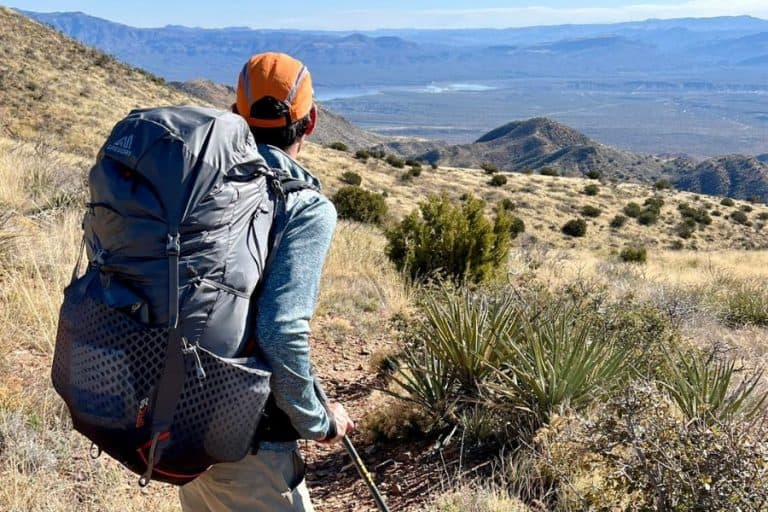
Some backpacking tents on the market weigh as little as one or two pounds.
But they achieve that featherweight by using premium materials, which are way out of the “budget” league.
That means that most budget backpacking tents are a bit heavier, ranging between three to six pounds.
Now, those added few pounds shouldn’t be a big issue for casual backpackers.
Especially if you’re camping with a friend, and you can split the tent weight by each of you carrying separate tent components.
Still, the difference in weight will be apparent if you plan on going very long distances. So, if you plan on backpacking frequently or long distances, we recommend investing in a more premium tent.
Now, here’s the thing with backpacking tents.
The indicated weight of the product usually includes every component, including poles, stakes, rainfly, footprint, etc. However, you don’t always need all those things.
Of course, the tent body, rainfly, and poles are the most important parts.
As for the others, those can be improvised on the go, thus helping you trim a bit of gear weight.
This will be indicated in the minimum trail weight for each tent.
Fabric Durability
Given that you’ll be out on the trail for a while, it’s important that the tent fabric is durable.
Now, figuring out exactly how durable a fabric is can be tough, as you don’t have a specific measurement for that.
But what you can do is take into consideration other characteristics, such as the thickness of the fabric.
Fabric thickness is measured in denier. To be precise, denier refers to the thickness of the individual fibers which make up the threads of fabric.
A higher denier means thicker fabric. Of course, denier won’t tell you everything about the fabric’s durability. But it helps you distinguish between different models.
With that being said, you want to pay attention to other details, like coatings and taped seams. It’s the little things that define how long-lasting a tent might be.
Weather Protection
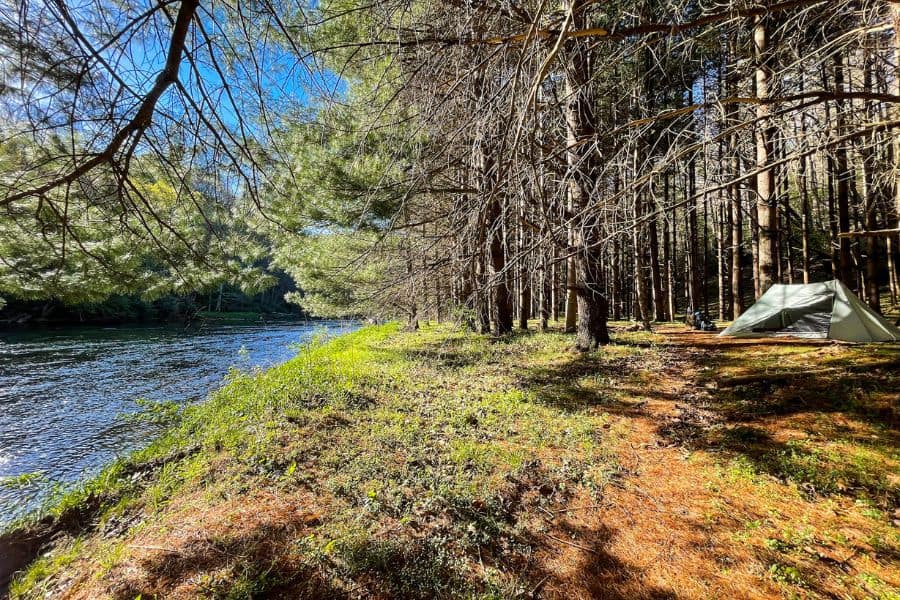
When you’re out on the trail, you can expect the weather to change at some point. And when it does, you don’t want the weather elements to send you home prematurely.
A backpacking tent needs to have at least decent weather protection.
When it comes to rain, that means a PU coating, taped seams, and a bathtub floor.
You should also pay attention to the rainfly and how well it protects the openings like doors and windows from rain.
As for the wind, you want a tent to have a sturdy structure. Dome tents perform really well in the wind, which is why they’re such a popular choice for backpacking.
But regardless of their shape, dome tents also need to be properly staked and tied with guylines to withstand heavy winds.
That’s why you should always look for a model with numerous guyline points, so that you can keep it taut and in place while it’s blowing outside.
Ventilation

Ventilation is also an important factor, especially during bad weather.
When it’s raining, you need to keep the rainfly on and openings closed to prevent rainwater from seeping in.
However, given that the air inside the tent is slightly warmer than the air outside, so condensation is bound to happen.
Unless your tent has a way of dealing with it, that is. Most tents have a mesh inner body to ensure decent airflow inside.
But when the rainfly is on and opening closed, it also needs some small vents on the rainfly to let some airflow in and out.
The more vents, the better. But in most cases, you can get away with just one, as long as it’s well-positioned.
Storage: Vestibules and Interior Pockets
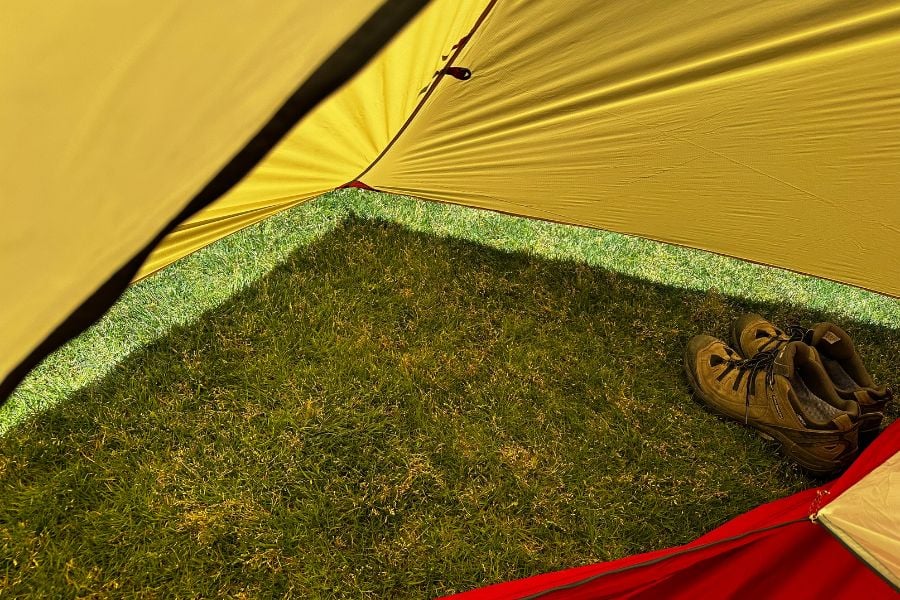
Backpacking tents aren’t designed to be spacious like a room. Instead, they offer just enough space for your sleeping bag. But what about gear?
Well, you have several options….first are the vestibules, which are a part of the rainfly covering the door.
Even in the budget range, most of these tents will come with ample vestibules offering enough room for your gear and your dirty boots.
As for interior organization, we don’t usually see a lot of bells and whistles at this price range.
At most, budget backpacking tents have a mesh pocket or two, and maybe a ceiling storage net.
Also See: The 9 Best Tents With Vestibules
FAQs
What should I look for in a cheap backpacking tent?
At the very least, it should have a decent water-resistance rating, vent openings, and be lightweight.
Another important feature, although small, is the zippers.
You want them to be high-quality and possibly have an anti-snag slider cover, to prevent damaging the door from constant opening and closing.
Is a 4 pound tent too heavy for backpacking?
Ideally, you want a backpacking tent to be featherweight, although that’s not always possible if you’re on a budget.
A four-pound tent is a decent option for backpacking, though there are much lighter tents available on the market today.
How much should I spend on a good backpacking tent?
As you can see from the list, you can find amazing products within any budget.
If you’re backpacking short trips a few times a year, most of the tents from our list will do more than fine.
However, if you spend a lot of time backpacking, it’s better to invest in something that can last you many years.
How much should a budget backpacking tent weigh?
A backpacking tent should weigh between 2 and 5 lbs, depending on its size and sleeping capacity. But as with everything backpacking, the lighter the better.
You can still use a heavier tent, but make sure that you can split the components between the backpackers to reduce the weight each of you is carrying.
To Sum Things Up
Backpacking tents come with various price tags, but our favorite budget backpacking tent is the REI Co-op Trailmade 2.
It offers decent headroom inside, two vestibules for storing gear outside and it comes with a footprint. What more can you ask for?
More Budget Tent Options:

